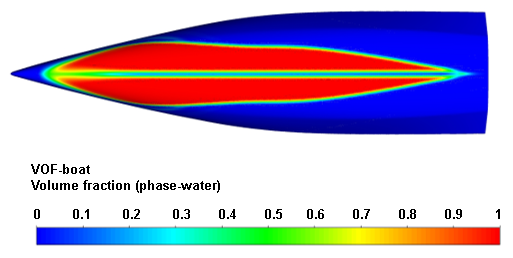The VOF model often suffers from unphysical trapping of the lighter phase near the wall boundary due to the limitation of the shared velocity formulation. This unphysical trapping, which is called numerical ventilation, leads to a significant underprediction of wall shear stresses and heat transfer rates. Using mesh refinement and other solution strategies can certainly help in minimizing the trapped phase, but this may not be sufficient due to fundamental limitations of the shared velocity formulation.
Numerical ventilation often arises during VOF simulations of vessels (such as planing hulls or yachts) where the bow creates an acute entrance angle with the free surface of the fluid (see Figure 15.2: Planning Hull).
To treat the trapped phase near the wall, the numerical ventilation mass sink term is added in the volume fraction of the trapped phase:
(15–16) |
where
This sink term is conditional and is imposed on the trapped phase only in the following cases:
In the wall neighboring cells
When the wall normal distance is below a specified threshold
When the volume fraction of the trapped phase is below a certain threshold
To create a distinct and crisp interface in the near wall cells, an additional mass sink term is added in the volume fraction equation of the non-trapped phases when the volume fraction of the trapped phase is above a certain threshold:
(15–17) |
where is the volume fraction of the non-trapped
phase.
Note that some optimization of user inputs may be required for the numerical ventilation treatment to work effectively. See Using the Numerical Ventilation Treatment for more information.
For VOF or mixture multiphase cases, you can use the Text User Interface (TUI) commands to enable the numerical ventilation treatment and adjust its parameters when beta feature access is enabled as described in Introduction. See Theory for more information about the numerical ventilation treatment.
Note that the treatment text commands are available only when the high resolution treatment is enabled.
To enable the numerical ventilation treatment, use the following text command:
solve/set/multiphase-numerics/advanced-stability-controls/num-ventilation/enable?enable numerical ventilation treatment [no]yesenter phase-id of trapped phase [0] 0
The phase ID of the primary phase is 0, the phase ID of the first secondary phase is 1, and so on.
Once the numerical ventilation treatment is enabled, you can modify its parameters using the following text commands:
solve/set/multiphase-numerics/advanced-stability-controls/num-ventilation/near-wall-treatment-optionsIndicates where the numerical ventilation treatment will be applied. The available options are:
0: the treatment will be applied in the wall neighboring cells1: the treatment will be applied in the cells where the wall normal distance is below a threshold that you specify at the next prompt:enter wall distance for numerical ventilation treatment [0.005]
solve/set/multiphase-numerics/advanced-stability-controls/num-ventilation/tau-estimation-optionsAllows you to select the definition method for the time step size (
in Equation 15–16 and Equation 15–17) for the numerical ventilation treatment. You can choose from the following options:
0: user-input1: a multiple of either the physical time-step (transient simulation) or the pseudo time-step (pseudo-transient simulation) specified in the Run Calculation task page
solve/set/multiphase-numerics/advanced-stability-controls/num-ventilation/trapped-phase-vof-maxSets the maximum volume fraction of the trapped phase above which the mass sink treatment for the non-trapped phases is invoked.
solve/set/multiphase-numerics/advanced-stability-controls/num-ventilation/trapped-phase-vof-minSets the minimum volume fraction of the trapped phase below which the mass sink treatment for the non-trapped phases is invoked.



